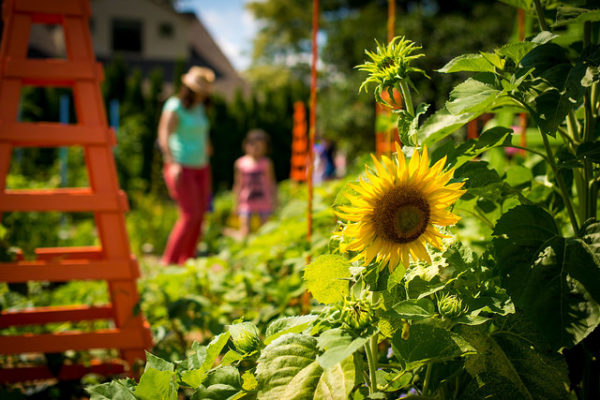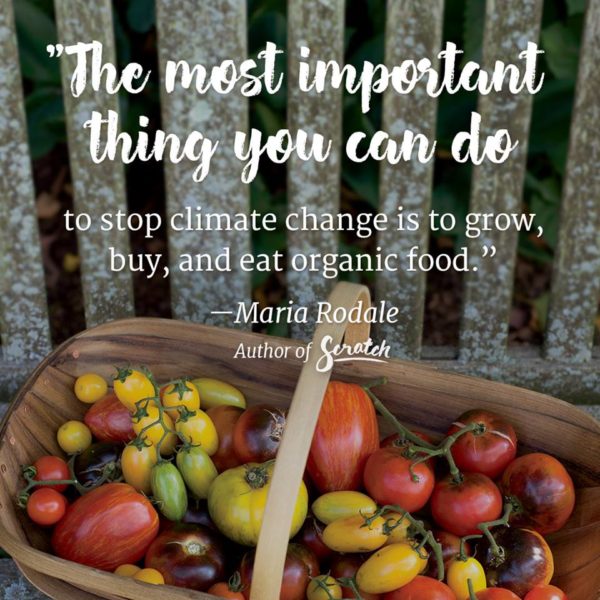
New England Botanic Garden at Tower Hill’s vegetable garden offers visitors ideas and inspiration.
By Robert Burgess
New England Botanic Garden at Tower Hill staff
The threat of climate change can seem daunting. What can the home gardener do to reduce his or her carbon footprint? A lot actually.
In many ways, you, the home gardener, are on the front lines. You have the ability to make daily decisions that affect your neighborhood’s environment and the global climate. If lots of individuals make earth-friendly decisions, the results can add up to make a big difference.
 1) Use organic gardening methods. Skip the chemical fertilizers, herbicides, and pesticides. Lots of fossil fuels are needed to create and transport those chemicals, and their run-off has an adverse effect on local waterways and wildlife. Reach out to the New England Botanic Garden at Tower Hill Horticultural Help Line when you need advice on how to confront a problem in your yard and garden. Often there are organic measures that can be taken before trying a chemical. For example, your plant might suffering from pests or diseases because its location is not ideal or a soil test is needed to determine if providing missing nutrients is needed.
1) Use organic gardening methods. Skip the chemical fertilizers, herbicides, and pesticides. Lots of fossil fuels are needed to create and transport those chemicals, and their run-off has an adverse effect on local waterways and wildlife. Reach out to the New England Botanic Garden at Tower Hill Horticultural Help Line when you need advice on how to confront a problem in your yard and garden. Often there are organic measures that can be taken before trying a chemical. For example, your plant might suffering from pests or diseases because its location is not ideal or a soil test is needed to determine if providing missing nutrients is needed.
2) Acquire used gardening equipment. Fossil fuels are used to manufacture and deliver gardening tools. So before buying something new, check around (on Facebook Marketplace, Craigslist, or at area yard sales) to see if there is a well-cared for option for sale that could accomplish what you need it to. Keep a wish list handy so you can purchase what you’ll need when you find it at the right price, rather than having to run out and buy something new on short notice because you need it right then. Or if it’s a tool you’ll only need once in a while, consider borrowing it from a neighbor.
3) Consider electric yard care machines. Not only are lawn mowers, weed trimmers, and chain saws built with fossil fuels, they also use fossil fuels that emit the CO2 that humankind needs to ween itself off off. In addition, traditional equipment adds to noise pollution in your community, affecting people and wildlife. There are many good plug in and battery powered options to choose from these days.

4) Invest in an edible landscape. The more food you grow and eat yourself, the fewer fossil fuels are needed to transport produce from far away, the fewer chemicals are needed to grow moniculture crops on far away factory farms, and the less plastic packaging is needed. Shrinking your lawn by replacing it with useful plants can be very rewarding, benefiting you, pollinators, wildlife, and the environment. Plus, there might not be a better way of tuning yourself in to the cycles of nature than growing your own food.
5) Compost. When you send your produce scraps to the landfill, they produce harmful methane gases as they decompose. On the flip side, when you add those scraps to a backyard compost pile, they break down into invaluable material the can be used to feed your plants and reduce the need for watering, which is more beneficial than any chemical fertilizer.
6) Plant native species. Native species of plants provide habitat for beneficial wildlife, but also often require less care than other plants. They are generally more drought and pest resistant. And they’re beautiful.
7) Share the wealth (of knowledge). Be a beacon for others looking to make eco-friendly decisions in their yards. You don’t need to preach if that’s not your style. Your neighbors will notice if you take the bag off your lawn mower and might inquire why you did, to which you can reply that leaving your clippings is a lazy and free way to feed your lawn. They may see you mulching your plants and garden beds with shredded leaves and be surprised to hear you say that it’s a free and easy way to reduce summer watering. One thing is for sure: Neighbors are always watching, so lead by example.
